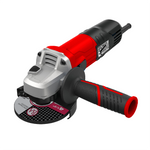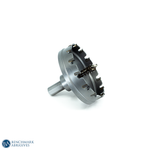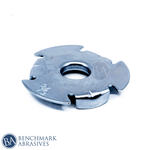
Which Sanding Belt is Better, Ceramic or Zirconia?

Selecting an appropriate sanding belt is essential for successful and efficient material removal and finishing. Ceramic and Zirconia sanding belts are the best choices to choose from. Both belts offer enhanced toughness, quick cutting action, and increased lifespan, which makes them suitable for a variety of applications, including metalworking and woodworking. Despite their similarities, these belts possess unique qualities that distinguish them from one another.
Determining which type of sanding belt offers the best results for your specific tasks requires understanding these variations in their abrasive grain features, performance under different pressures, heat resistance, and cost.
In this blog, we will discuss ceramic or zirconia sanding belts, their applications, differences, and how to choose between them.
CERAMIC SANDING BELT: WHAT IS IT?

A ceramic sanding belt is a high-quality abrasive tool particularly made for efficient material removal and finishing. It uses ceramic abrasive grains renowned for their outstanding toughness, sharpness, and durability. These grains are mostly made using the sol-gel technique, which generates a microcrystalline structure that enables controlled fracturing and further results in self-sharpening of grains.
KEY FEATURES OF CERAMIC SANDING BELTS
Here are the key features of ceramic sanding belts:
- SUPERIOR HARDNESS AND SHARPNESS: Ceramic grains have superior hardness and sharpness, so they can cut aggressively through various materials, including hard metals and some hardwoods.
- SELF-SHARPENING ABILITY: The ceramic belts feature a microcrystalline structure that encourages constant fracturing, exposing new cutting edges and maintaining a steady cutting action throughout the belt's life.
- LONGER LIFESPAN: These belts typically have a longer lifespan than aluminum oxide or zirconia in many applications because of their durability and self-sharpening properties.
- VERSATILITY ON METALS: Ceramic belts excel at working with a wide range of materials. They're particularly effective on ferrous metals like carbon steel, stainless steel, and various other steels. They also perform exceptionally well on non-ferrous metals such as titanium and aluminum, and even superalloys.
- STURDY BACKING: To withstand the stress of high-pressure applications, the ceramic abrasive is stuck to a sturdy backing material, which is made of stiff polyester or poly-cotton mix fabric
- IDEAL FOR WET OR DRY GRINDING: Some ceramic belts are made for wet and dry applications based on specific construction and materials.
APPLICATION OF CERAMIC SANDING BELTS
One of the primary applications of ceramic sanding belts is complex material removal and finishing, particularly in metalworking. Aggressive grinding and deburring, quick stock removal, rust removal, effective weld blending, and surface preparation are some of the primary uses. Ceramic belts are also used in knife making, as well as in the Aerospace and automotive sectors. Although they perform well in shaping hardwood in woodworking, their strength is in working with difficult materials where longevity and a smoother cut are essential.
PROS OF CERAMIC SANDING BELTS
The following are the pros of ceramic sanding belts:
- Ceramic sanding belts usually have a longer lifespan compared to zirconia sanding belts.
- Ceramic sanding belts are popular for aggressive cutting action or quick material removal.
- Due to their microcrystalline structure, ceramic sanding belts have a self-sharpening ability, which exposes new, sharp cutting edges.
- Ceramic sanding belts are perfectly suitable for rigid materials, including hardened steel, stainless steel, etc.
- Ceramic sanding belts are suitable for producing more accurate results due to their cooler and controlled cutting action.
CONS OF CERAMIC SANDING BELTS
The following are the cons of ceramic sanding belts:
- Ceramic sanding belts are generally expensive when compared to other abrasive belts.
- Although these belts are typically made to cut cooler, they can still generate a significant amount of heat while applying excessive pressure, which can damage the workpiece or reduce the belt’s life.
- Ceramic belts are unsuitable for cutting soft materials as they are aggressive.
- Ceramic sanding belts are less flexible as they have stiffer backing for challenging applications, making them less preferred for complex or intricate jobs
- To fully utilize ceramic belts, it is advised to use a sanding machine with enough power and speed to deliver the required pressure.
ZIRCONIA SANDING BELTS: WHAT IS IT?
A zirconia sanding belt is a type of abrasive belt with zirconia alumina as its main abrasive grain. Zirconia alumina is a synthetic abrasive popularly known for its hardness, durability, and self-sharpening qualities. Compared to traditional aluminum oxide belts, these belts improve performance and durability, making them a preferred choice for metalworking and woodworking applications.
KEY FEATURES OF ZIRCONIA SANDING BELTS
The following are the key features of ceramic sanding belts:
- ZIRCONIA ALUMINA ABRASIVE: The foundation of these belts is the zirconia alumina grain, making it more challenging and complex than aluminum oxide. This offers a more aggressive cut and increases the lifespan of the belt.
- SELF-SHARPENING QUALITIES: Zirconia alumina grains are made to micro-fracture when in use. This mechanism exposes new, sharp cutting edges, which help maintain a consistent cutting action throughout the belt's life.
- STRONG HEAT RESISTANCE: Zirconia abrasives are suitable for high-pressure applications because of their high heat resistance, which helps prevent excessive heat accumulation that can damage the workpiece or the belt.
- VERSATILITY: Zirconia sanding belts are highly versatile, as they can be used on a wide range of materials, including steel, aluminum, titanium, nickel alloys, cast iron, and hardwoods.
- COST-EFFECTIVE: Although they are often more costly than aluminum oxide belts, they are frequently a more economical option over time due to their longer lifespan and quicker cutting action.
- FREQUENTLY USE GRINDING AIDS: Some zirconia belts come with a "top coat," often called a grinding aid, to minimize heat and avoid loading, mainly when dealing with softer metals.
APPLICATIONS OF ZIRCONIA SANDING BELTS
Zirconia sanding belts are highly versatile abrasive tools, primarily used for shaping and finishing a variety of materials. Additionally, these belts are effective for blending welds, removing corrosion and rust, and quickly eliminating large amounts of stock to shape and profile metal components.
Zirconia belts are great for intensive hardwoods and getting surfaces ready for finishing in woodworking. They also shape and finish fiberglass, composites, and some plastics. Due to their self-sharpening ability and durability, they are also a great option in steel fabrication, knife making, and preparing components in the automotive and aerospace sectors.
PROS OF ZIRCONIA SANDING BELTS
The following are the pros of Zirconia sanding belts:
- Zirconia sanding belts generally have a longer lifespan compared to aluminum oxide belts.
- They remove material more quickly and efficiently compared to aluminum oxide or ceramic belts.
- The zirconia alumina grains continuously expose new, sharp edges, ensuring consistent, optimal performance.
- Zirconia sanding belts can withstand the high heat generated during the sanding process.
CONS OF ZIRCONIA SANDING BELTS
The following are the cons of zirconia sanding belts:
- Zirconia sanding belts have a shorter lifespan than ceramic belts and are unsuitable for complex projects, particularly on hard materials.
- In some cases, zirconia sanding belts produce more heat when applying excessive pressure compared to ceramic sanding belts
- They are not ideal for heat-sensitive materials.
- Zirconia sanding belts require enough pressure to start the micro-fracturing process. If the pressure is too low, the grain becomes dull instead of self-sharpening
- When used for softer materials, Zirconia sanding belts tend to get clogged if not used correctly.
CERAMIC SANDING BELT VS ZIRCONIA SANDING BELTS: WHICH IS BETTER?
Selecting the right sanding belt often comes down to your use case and priorities. Deciding between zirconia and ceramic sanding belts is better as it typically relies on the specific use and user priorities. Ceramic belts are often the best choice for challenging jobs, including dealing with titanium, stainless steel, or knife-making. These belts have the quickest cutting action and the longest lifespan. They perform really well on particularly hard materials and in cases where reducing heat is vital. However, ceramic belts are typically more costly initially.
As an alternative to aluminum oxide, zirconia belts are more adaptable and economical. They offer a good balance between cutting power and durability in a broader range of materials, such as metals and hardwoods, and they work remarkably well under mild to high pressure for tasks like stock removal and weld blending. Therefore, the "better" sanding belt is a matter of opinion. It relies on whether longevity and maximum performance (ceramic) or a more adaptable and cost-effective high-performance choice (zirconia) are more critical.



































































